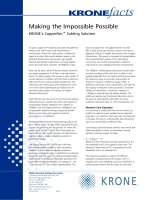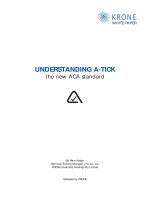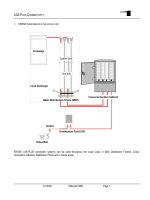MERAKI WHITE PAPER: WIRELESS LAN SECURITY pdf
Bạn đang xem bản rút gọn của tài liệu. Xem và tải ngay bản đầy đủ của tài liệu tại đây (473.34 KB, 13 trang )
Robust security is a requirement for many companies deploying a
wireless network. However, creating a secure wireless network has
often been difficult and time-consuming. This paper describes the
security requirements for most companies and how Meraki can help
them meet those challenges easily and at a low cost.
Copyright
â 2009 Meraki, Inc. All rights reserved.
Trademarks
Merakiđ is a registered trademark of Meraki, Inc.
www.meraki.com
660 Alabama St.
San Francisco, California 94110
Phone: +1 415 632 5800
Fax:
+1 415 632 5899
While security is important for all networks, wireless LANs deserve
special consideration since they are subject to an increased level of risk.
First, since wireless extends beyond the walls of an organization,
physical security is less effective than with wired networks. Second,
wireless network abuse has become more common, with tools that assist
wireless hacking widely available, and companies are a target. Finally,
802.11 protocols operate on unlicensed spectrum using well-understood
protocols, resulting in a proliferation of devices that are able to access a
corporate network.
Wireless networks are also subject to several regulations that mandate
the high security networks, including PCI, HIPAA, and SOX. The credit
card industry requires those processing credit card transactions to
comply with PCI standards, in order to mitigate the chances of card
number theft and fraud. All merchants using payment cards must build
and maintain a secure network, protect and encrypt cardholder data, and
regularly monitor and test their networks, including wireless networks.
The Health Insurance Portability and Accountability Act (HIPAA) was
enacted by the U.S. Congress in 1996. Many health care institutions are
covered by it and are required to maintain administrative, technical, and
physical safeguards to ensure integrity and confidentiality of patient data.
Wireless networks are potentially vulnerable and must be secured in
order to comply.
Finally, public companies are subject to the Sarbanes-Oxley act (SOX)
and similar measures outside the U.S. SOX requires companies to
maintain and assess internal control structures and procedures for
financial reporting and to assess the effectiveness of these internal
control structures. Network security is typically part of the control review.
Thus, a combination of regulatory requirements, as well as common
sense, make wireless security an important consideration.
There are many possible methods to implement wireless security. An
understanding of which methods are ineffective, and why, is necessary in
order to avoid them.
Some companies have attempted to contain the wireless signal within
the physical perimeter of the coverage area. Specialized directional
antennas might be used for this purpose. In reality, RF propagation is
highly unpredictable. WiFi signals reflect off of walls, as well as furniture
and other everyday objects, which may be moved as an office is
reconfigured. It is inevitable that some wireless signal will penetrate
beyond the confines of most buildings, so it is best to assume that
outsiders will have a signal strong enough to attempt to access the
network.
Service Set Identifier (SSID) cloaking is another ill-advised security
strategy. Software that allows non-technical users to find and associate
with hidden SSIDs is readily available on the Internet. While hiding
SSIDs may deter the most casual intruder, it is not sufficient to protect
the network. Worse, it can impair usability as the trusted user may
struggle to associate with the network.
Each 802.11 client has a unique MAC address assigned at the time of
manufacture. It is possible to restrict access to a network to only
approved MAC addresses. Unfortunately, this approach has a number of
drawbacks. First, it is difficult to administer: keeping track of long lists of
MAC addresses is error-prone and cumbersome. Second, it is
fundamentally insecure. Software is commonly available that allows a
client to change (or “spoof”) its MAC address. An intruder can simply
listen to the wireless traffic, identify an authorized MAC address, and set
his MAC address accordingly. This exploit requires just a few minutes to
execute.
Wireless Equivalency Protocol, or WEP, was the 802.11 group’s first
security mechanism. Unfortunately, it proved very easy to break WEP,
and tools to do so are widely available. As a result, WEP is typically not
considered secure enough for corporate use. Worse, it may give users a
false sense of security.
While there are many ways to set up a secure wireless system, we will
describe three that are applicable to a wide variety of environments. This
section describes the security configuration of an employee or trusted
network. Later, we discuss how to treat guests through the use of a
separate Virtual Access Point (also known as a separate SSID).
An “open with VPN” approach starts with the assumption that all wireless
data is insecure. Neither encryption nor authentication is performed
before users are allowed to get on the network. Typically, users who get
on the network are able to access the Internet but not able to access the
LAN. Those who need LAN access must VPN into the corporate
network, as if they were coming in from outside the building.
There are at least three ways to prevent traffic on the open network from
accessing the corporate LAN. A common approach is usage of VLAN
tagging to isolate all wireless traffic outside the firewall. This approach is
simple and effective, but does require that the company’s switches
support VLANs and, depending on the given wired infrastructure, can be
difficult to configure and maintain. Alternately, Meraki provides an
integrated LAN Isolation feature. LAN Isolation causes wireless routers
to drop all packets destined for the LAN, and only allow Internet traffic to
proceed. The final approach is to use a separate wired network and
Internet connection. This approach is expensive but simple and highly
secure.
The major advantage of the open architecture is its simplicity. No special
client configuration is necessary. In addition, the security principle is
straightforward: all wireless traffic is untrusted. Anyone wishing to access
corporate resources is treated as if they are coming from outside the
firewall and must VPN.
There are drawbacks to this approach. First, VPN access can be
inconvenient to users and deter them from using the wireless network.
Second, not all clients support VPN, especially devices like PDAs and
scanners. Finally, load on the VPN server will likely increase, which can
add cost.
In the shared key approach, all authorized clients receive a secret key.
The key might be provided to employees or installed on their machine by
an IT administrator. While there are three shared key mechanisms
(WEP, WPA, and WPA-2), Meraki recommends WPA-2 since it is the
most secure. As mentioned above, WEP is not secure and should be
avoided.
All traffic that comes in through WPA2-PSK is typically allowed access to
the corporate LAN.
The shared key approach can be highly effective for small to midsize
organizations. It is simple and supported by almost all clients, including
PDAs and scanners.
The most significant drawback of the shared keys is that they can be
difficult to administer. If an employee who knows the key leaves the
organization, the key might need to be changed for everyone in order to
keep the network secure. In addition, knowledge of the key may leak
outside the organization, enabling outsiders to access the corporate
network.
WPA2-Enterprise, also known as 802.1x, is considered by many to be
the “gold standard” of wireless security. In this architecture, each client
(known as a supplicant) uses a unique username and password to
authenticate on the wireless network. The client’s username and
password are checked against any Active Directory or LDAP server that
supports the RADIUS protocol (and most do). Meraki supplies an
integrated RADIUS server that companies can use instead of a standalone server if they wish.
The primary advantages of WPA2-Enterprise are that it is highly secure
and scales well. IT administrators can re-use their existing authentication
infrastructure, so as employees come and go they are automatically
added and removed from the wireless network. There is also no need to
VPN.
Since 802.1x is a relatively new standard, client support is still evolving.
As of 2009, support is common on most laptop and PC operating
systems. However, support for PDAs, scanners, and other devices still
varies. In addition, client configuration can sometimes be complex.
While implementation of 802.1x has often been highly complex, Meraki
has simplified the process significantly. 802.1x takes just a few clicks to
deploy, and is no more difficult than implementing WPA2-PSK.
Meraki allows modular use of the features of any of the recommended
architectures described above in a “mix and match” manner. For
example, one might offer a WPA2-Enterprise solution for all Windows
and Mac users using the standard corporate image. Clients that lack
802.1x support would use the open network and VPN back in if needed.
The following table summarizes the advantages and disadvantages of
the approaches described above.
Client support
3
3
2
Scalability
4
1
4
Employee convenience
1
3
3
Security
4
3
4
Guests, consultants, and contractors frequently need to connect to the
company’s network. These people typically need access to the Internet
only, or more rarely, to a limited number of network resources such as
printers and file shares. Meraki recommends creating a separate Virtual
Access Point for use by guests, with its own SSID and security policies.
There are a number of security strategies that can be applied to guests,
including open and registered. In the open scenario, any client can
associate with and use the network. Administrators might choose to
display a splash page with terms of service. In the registration scenario,
guests are given a username and password, perhaps provided to them
by their host or the receptionist. The username might be static, e.g.,
“guest,” or could be unique to that specific guest. Meraki provides a tool
for receptionists and other non-technical staff to easily add guests to the
guest network. This way, the company knows exactly who is accessing
its network.
Once authorized, guest traffic is typically placed on a separate VLAN
using the Meraki LAN Isolation feature. For more details on guest
access, please see the Meraki Guest Access White Paper.
Meraki’s virtual network isolation feature allows companies to run
multiple networks that have completely different security policies. The
following table shows a typical security configuration for a corporate
network featuring guest access and wireless VOIP phones.
Users
Employees
Guests
Phones
SSID
Corp
Guest Access
Corp – VOIP
LAN & Internet
Internet only
LAN & Internet
Unlimited
5 mbit/s
Unlimited
Normal
Normal
High
802.1x / LDAP
Open
WPA2-PSK
Network
Access
Client
bandwidth
Quality of
service
Authentication
Meraki offers some unique benefits when building a secure, scalable
wireless system. The key advantages include extreme ease of use,
consistent management across multiple sites, and cost effectiveness.
While many systems tout ease of use, field deployment interviews
suggest that the reality differs from the sales talk. Many systems still
feature archaic command-line interfaces, require multi-day training
courses and certification programs, and publish 500-page manuals.
Effective security need not have such extensive requirements. Further,
when security is made complex to this degree, the chances of
configuration errors and unintended consequences increase.
Meraki offers a powerful yet streamlined security interface. The system is
managed entirely through a modern, hosted graphical web interface. In
addition, there are very few moving parts. The only pieces of hardware
on the company’s site are the access points. There are no controllers in
the DMZ or complex multi-site tunnels to create.
Meraki also makes it easy to ensure that security policies are applied
consistently throughout organizations with multiple sites. All networks for
the organization are visible from a single account. For example, a
company might have a corporate headquarters, branch offices, and
manufacturing plants. Reports for the networks at each location can be
received by both the centralized IT team as well as local administrators.
Finally, because the networks are so easy to establish, it is possible to
create secure networks in employee homes, or on a temporary basis
(e.g., at a sales conference).
Finally, Meraki does not place an undue burden on the existing wired
network infrastructure. For example, VLANs can be used to segregate
wireless traffic, but Meraki also provides an integrated traffic segregation
facility. Meraki also includes a number of other integrated security
services, such as integrated bandwidth limits (for guests), or integrated
adult content filters (for compliance).
Companies deploying a wireless network need to take security into
consideration. However, security does not need to be difficult and timeconsuming. Meraki makes it easy to implement the security policy that
works best for a particular organization, whether it has ten clients or tens
of thousands.
1. Meraki Guest Access White Paper
2. Meraki Network Design Guide
These documents are available for download at meraki.com.









